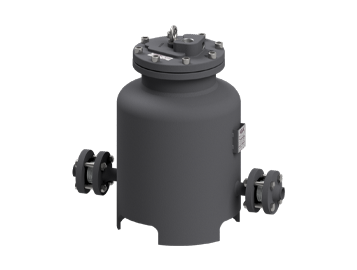Pressure operated pump POP-LC (Low Capacity)
The ADCAMat POP-LC low capacity pressure operated pump is recommended in the transfer of steam condensate, oils and other non-hazardous liquids compatible with the construction, to a higher elevation or pressure.
Under certain conditions, it can drain a closed vessel under vacuum or pressure.The pump can be operated using steam, compressed air or other gases, and is manufactured in carbon steel or stainless steel.
- Compact design.
- Hardened stainless steel wear parts.
- High-endurance inconel springs.
- Low filling head to minimize installation space.
- No electric requirements or NPSH issues.
- Suitable for hazardous environments.
- Low running costs.
- Pump mechanism with 360º rotation (limited to flange bolt holes).
- Level gauge.
- Stroke counter.
To lift steam condensate and other liquids compatible with the construction.
POP-LCS – carbon steel.
POP-LCSS – stainless steel.
1" x 1", 11/2" x 1", 11/2" x 11/2".
DN 25 x 25, DN 40 x 25 and DN 40 x 40.
Flanged EN 1092-1 PN 16.
Flanged ASME B16.5 Class 150.
Female threaded ISO 7 Rp (threaded flanges).
Others on request.
Horizontal installation. An example is shown in Fig. 1. See IMI – Installation and maintenance instructions.
MOTIVE MEDIUM
Saturated steam, compressed air, nitrogen and other gases.
Liquid flows by gravity into the pump through an inlet check valve, lifting the float. At this point, the motive fluid intake valve is closed while the vent valve is open. As the float reaches its highest position the motive fluid intake valve opens and the vent valve closes, allowing the motive fluid to enter the pump body. The pressure in the pump builds up just enough to overcome backpressure.
The pressurized liquid opens the outlet check valve and the discharge starts. The liquid discharged may be quantified through a special counter, enabling the pump to function as a reliable flow meter.
When the float reaches its lower position the motive fluid intake valve closes and the vent valve opens allowing the liquid to fill the pump once again, repeating the cycle.

